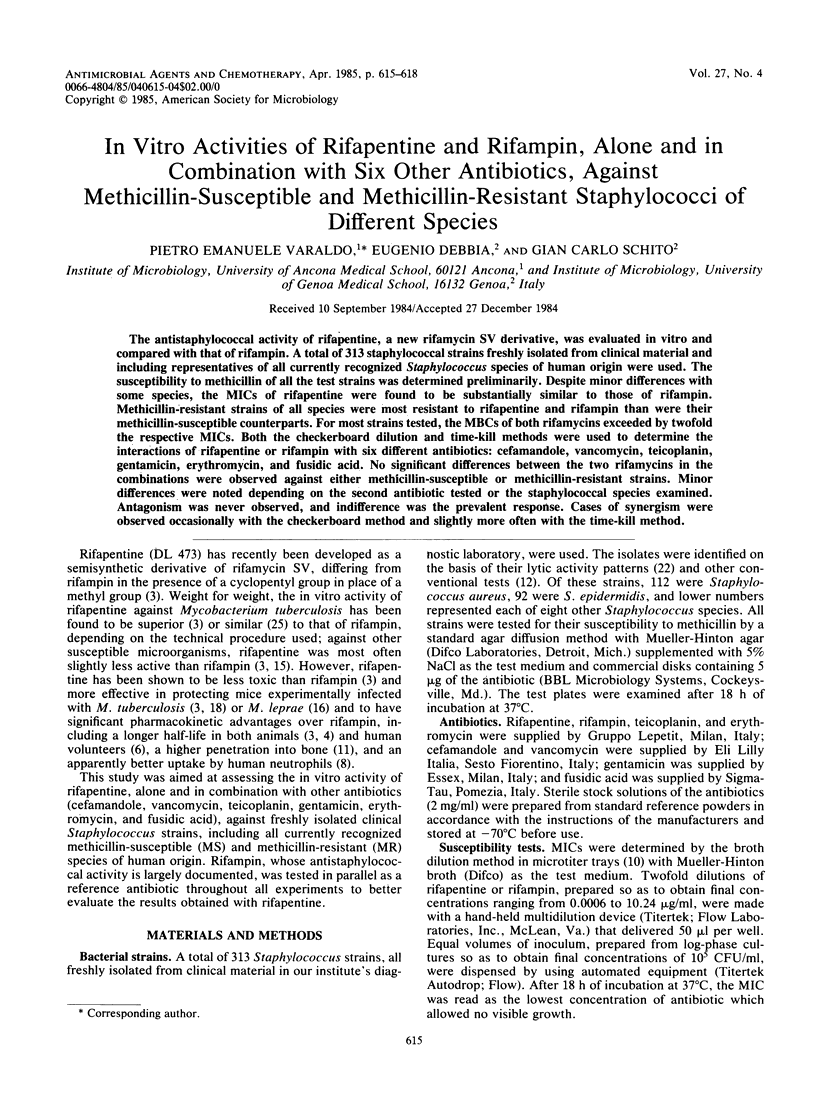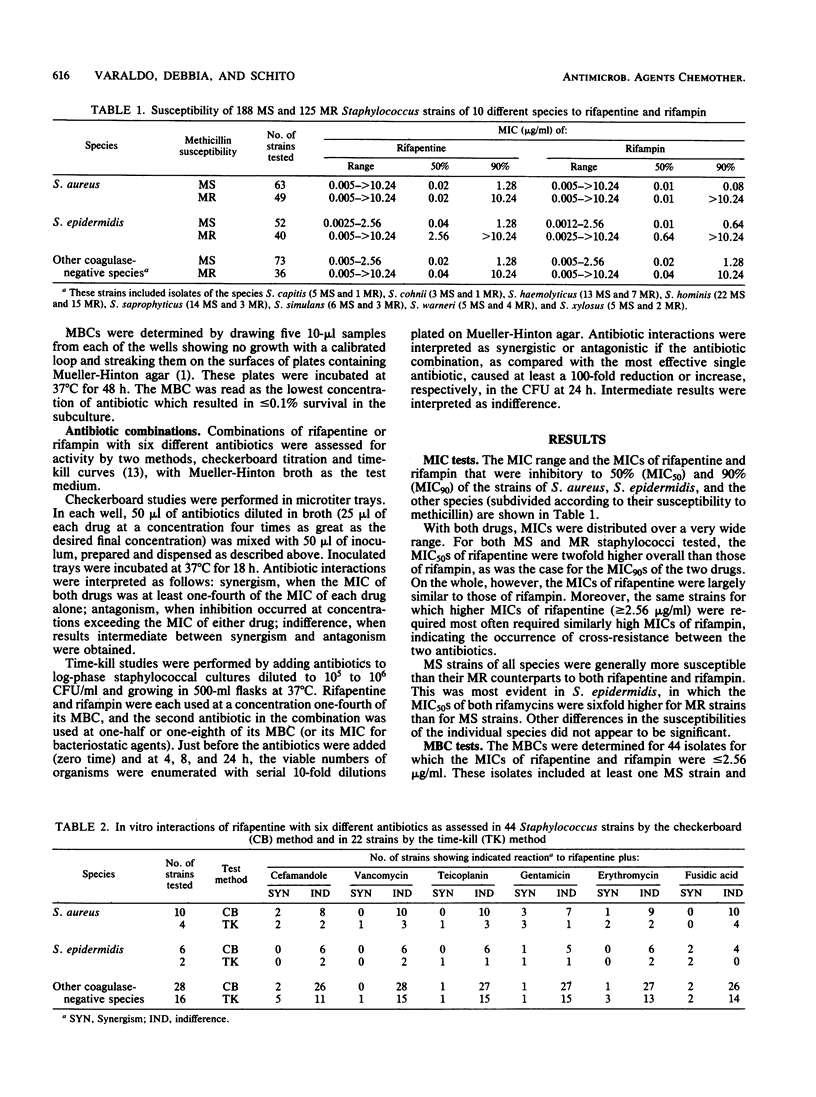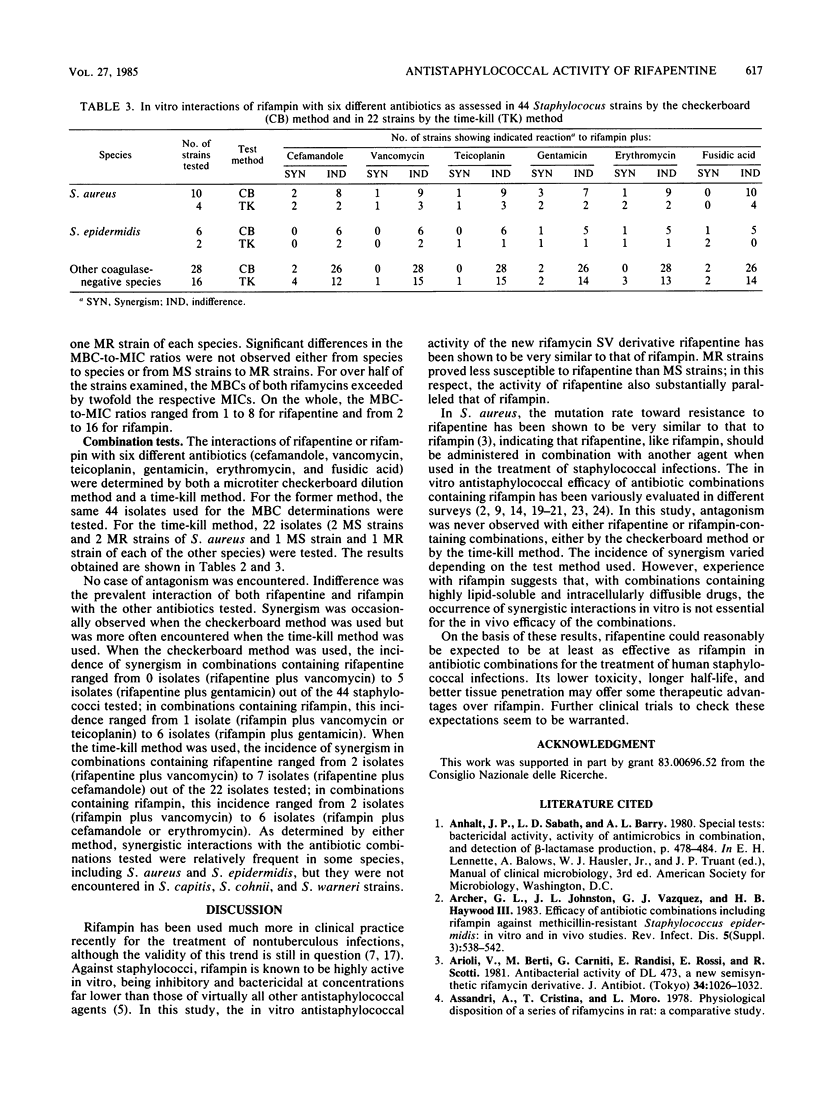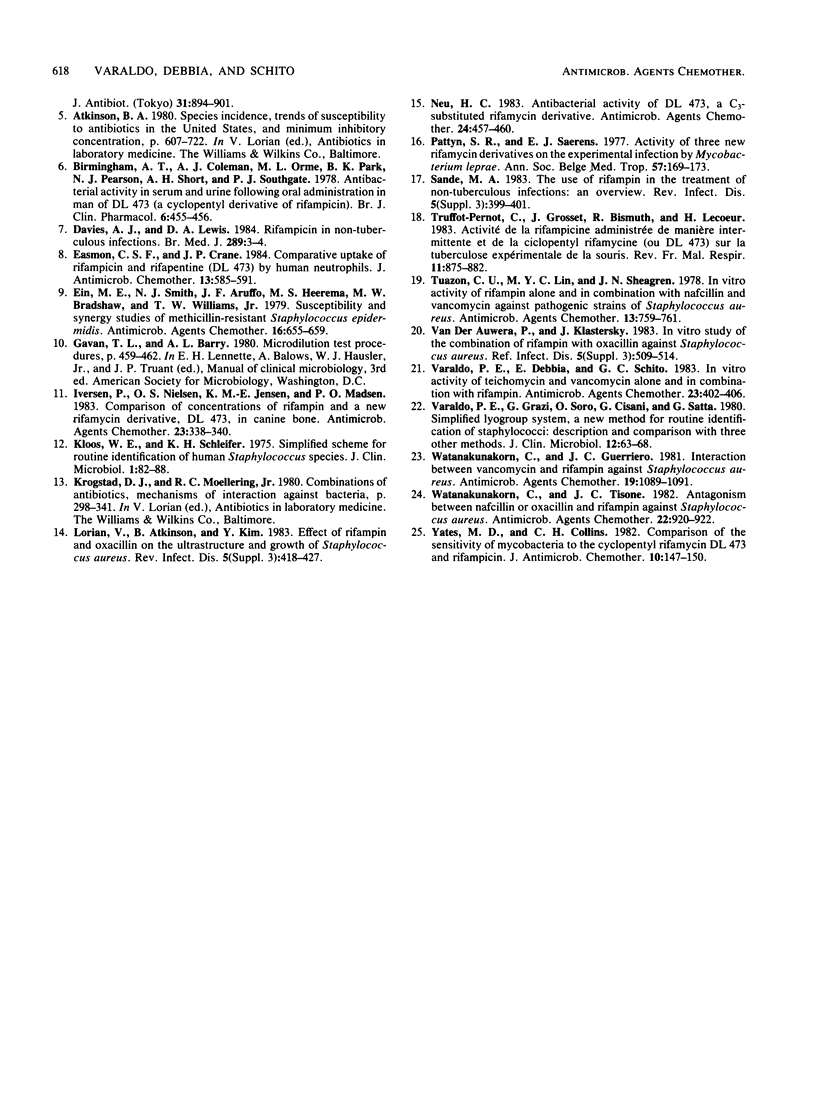Abstract
The antistaphylococcal activity of rifapentine, a new rifamycin SV derivative, was evaluated in vitro and compared with that of rifampin. A total of 313 staphylococcal strains freshly isolated from clinical material and including representatives of all currently recognized Staphylococcus species of human origin were used. The susceptibility to methicillin of all the test strains was determined preliminarily. Despite minor differences with some species, the MICs of rifapentine were found to be substantially similar to those of rifampin. Methicillin-resistant strains of all species were most resistant to rifapentine and rifampin than were their methicillin-susceptible counterparts. For most strains tested, the MBCs of both rifamycins exceeded by twofold the respective MICs. Both the checkerboard dilution and time-kill methods were used to determine the interactions of rifapentine or rifampin with six different antibiotics: cefamandole, vancomycin, teicoplanin, gentamicin, erythromycin, and fusidic acid. No significant differences between the two rifamycins in the combinations were observed against either methicillin-susceptible or methicillin-resistant strains. Minor differences were noted depending on the second antibiotic tested or the staphylococcal species examined. Antagonism was never observed, and indifference was the prevalent response. Cases of synergism were observed occasionally with the checkerboard method and slightly more often with the time-kill method.
Full text
PDF



Selected References
These references are in PubMed. This may not be the complete list of references from this article.
- Arioli V., Berti M., Carniti G., Randisi E., Rossi E., Scotti R. Antibacterial activity of DL 473, a new semisynthetic rifamycin derivative. J Antibiot (Tokyo) 1981 Aug;34(8):1026–1032. doi: 10.7164/antibiotics.34.1026. [DOI] [PubMed] [Google Scholar]
- Davies A. J., Lewis D. A. Rifampicin in non-tuberculous infections. Br Med J (Clin Res Ed) 1984 Jul 7;289(6436):3–4. doi: 10.1136/bmj.289.6436.3. [DOI] [PMC free article] [PubMed] [Google Scholar]
- Easmon C. S., Crane J. P. Comparative uptake of rifampicin and rifapentine (DL473) by human neutrophils. J Antimicrob Chemother. 1984 Jun;13(6):585–591. doi: 10.1093/jac/13.6.585. [DOI] [PubMed] [Google Scholar]
- Ein M. E., Smith N. J., Aruffo J. F., Heerema M. S., Bradshaw M. W., Williams T. W., Jr Susceptibility and synergy studies of methicillin-resistant Staphylococcus epidermidis. Antimicrob Agents Chemother. 1979 Nov;16(5):655–659. doi: 10.1128/aac.16.5.655. [DOI] [PMC free article] [PubMed] [Google Scholar]
- Hinman A. R., Kirby C. D., Eddins D. L., Orenstein W. A., Bernier R. H., Turner P. M., Bart K. J. Elimination of indigenous measles from the United States. Rev Infect Dis. 1983 May-Jun;5(3):538–545. doi: 10.1093/clinids/5.3.538. [DOI] [PubMed] [Google Scholar]
- Iversen P., Nielsen O. S., Jensen K. M., Madsen P. O. Comparison of concentrations of rifampin and a new rifamycin derivative, DL 473, in canine bone. Antimicrob Agents Chemother. 1983 Feb;23(2):338–340. doi: 10.1128/aac.23.2.338. [DOI] [PMC free article] [PubMed] [Google Scholar]
- Kloos W. E., Schleifer K. H. Simplified scheme for routine identification of human Staphylococcus species. J Clin Microbiol. 1975 Jan;1(1):82–88. doi: 10.1128/jcm.1.1.82-88.1975. [DOI] [PMC free article] [PubMed] [Google Scholar]
- Neu H. C. Antibacterial activity of DL 473, a C3-substituted rifamycin derivative. Antimicrob Agents Chemother. 1983 Sep;24(3):457–460. doi: 10.1128/aac.24.3.457. [DOI] [PMC free article] [PubMed] [Google Scholar]
- Pattyn S. R., Saerens E. J. Activity of three new rifamycin derivates on the experimental infection by Mycobacterium leprae. Ann Soc Belg Med Trop. 1977;57(3):169–173. [PubMed] [Google Scholar]
- Truffot-Pernot C., Grosset J., Bismuth R., Lecoeur H. Activité de la rifampicine administrée de manière intermittente et de la cyclopentyl rifamycine (ou DL473) sur la tuberculose expérimentale de la souris. Rev Fr Mal Respir. 1983;11(6):875–882. [PubMed] [Google Scholar]
- Tuazon C. U., Lin M. Y., Sheagren J. N. In vitro activity of rifampin alone and in combination with nafcillin and Vancomycin against pathogenic strains of Staphylococcus aureus. Antimicrob Agents Chemother. 1978 May;13(5):759–761. doi: 10.1128/aac.13.5.759. [DOI] [PMC free article] [PubMed] [Google Scholar]
- Varaldo P. E., Debbia E., Schito G. C. In vitro activity of teichomycin and vancomycin alone and in combination with rifampin. Antimicrob Agents Chemother. 1983 Mar;23(3):402–406. doi: 10.1128/aac.23.3.402. [DOI] [PMC free article] [PubMed] [Google Scholar]
- Varaldo P. E., Grazi G., Soro O., Cisani G., Satta G. Simplified lyogroup system, a new method for routine identification of staphylococci: description and comparison with three other methods. J Clin Microbiol. 1980 Jul;12(1):63–68. doi: 10.1128/jcm.12.1.63-68.1980. [DOI] [PMC free article] [PubMed] [Google Scholar]
- Watanakunakorn C., Guerriero J. C. Interaction between vancomycin and rifampin against Staphylococcus aureus. Antimicrob Agents Chemother. 1981 Jun;19(6):1089–1091. doi: 10.1128/aac.19.6.1089. [DOI] [PMC free article] [PubMed] [Google Scholar]
- Watanakunakorn C., Tisone J. C. Antagonism between nafcillin or oxacillin and rifampin against Staphylococcus aureus. Antimicrob Agents Chemother. 1982 Nov;22(5):920–922. doi: 10.1128/aac.22.5.920. [DOI] [PMC free article] [PubMed] [Google Scholar]
- Yates M. D., Collins C. H. Comparison of the sensitivity of mycobacteria to the cyclopentyl rifamycin DL473 and rifampicin. J Antimicrob Chemother. 1982 Aug;10(2):147–150. doi: 10.1093/jac/10.2.147. [DOI] [PubMed] [Google Scholar]


